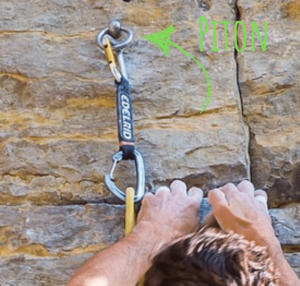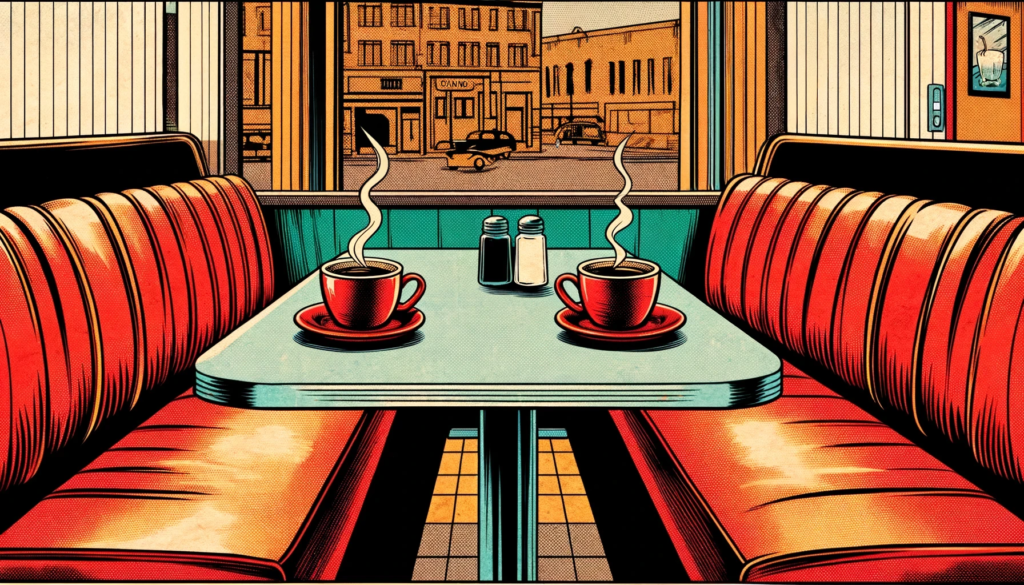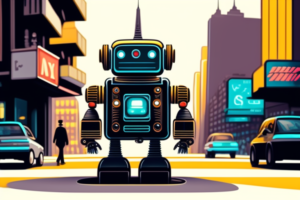"Hey! Let's Meet for Coffee!"
There’s something about being asked to join someone for coffee OR being the one who does the asking.
It signifies that a connection has been made between two people.
But not just any connection. It’s one that means you and another human being actually want to spend time together. You’re actively seeking out each other’s company. And that’s a wonderful thing.
Here’s a question: If brands were people, are there any that you’d want to grab a cup-a-Joe with?
I can only think of a few I’d love to do that with. Patagonia and Ben & Jerry’s are two that come to mind first.
“But they’re HUGE businesses with HUGE marketing budgets,” you might be saying. “I’m a solopreneur with a small business and a small (or non-existent) marketing budget. So, there’s no way I can be as successful as they are when it comes to connecting with my audience.”
If you and I were on a game show right now (with me as the host, of course), I’d push a buzzer and say, “INCORRECT!”
Neither Patagonia nor Ben & Jerry’s started out as the large companies that they are now.
Instead, Patagonia was founded by Yvon Chouinard — a climber who started a piton-forging business in his parents’ garage. (BTW, a piton is a metal spike that climbers hammer into whatever surface they’re on — such as rock or ice — to provide support.)

Ben & Jerry’s was started by Ben Cohen and Jerry Greenfield — two friends who shared a passion for ice cream and social activism. They took a $5 correspondence course in ice cream making, secured $12,000 in funding and served up their first delicious scoops in a renovated gas station in Burlington, Vermont.
Neither started with a big marketing budget — but both set out with big ideas and big beliefs. That’s what drew people to them in the first place. They were tiny start-ups with mighty hearts. And, as they grew into really, REALLY big companies over the decades, their hearts have stayed mighty and people continue to be drawn to them.
It wasn’t a large marketing budget that connected them with their ideal customers. Instead, it was their values that forged such strong connections — and still do.
Are there other businesses where I can get quality outdoor gear? Of course.
Are there other places I could go for yummy ice cream? Yep.
So, why would I choose these two brands to have coffee with when there are so many other perfectly acceptable options?
Because I love what they stand for and respect how they’ve stayed true to their core values over the decades. These brands are my people — and I love spending time with them.
And, as solopreneurs, this should be the goal for our brands. We need to be coffee-worthy in the hearts and minds of our ideal customers.
Neither Ben & Jerry's nor Patagonia started with a big marketing budget — but both set out with big ideas and big beliefs. That's what drew people to them in the first place. They were tiny start-ups with mighty hearts.
Michele Lashley, The Story Sandbox Tweet
How to Make Your Brand Coffee-Worthy
Having a large marketing budget has ZERO bearing on a brand’s coffee-worthiness.
Cash isn’t the currency when it comes to building a brand that your ideal customers want to hang out with. The real currency is connection.
You’ve heard it a million times, but I’ll say it again for those in the back of the room:
Before people will buy from your store, donate to your cause, join your movement, or vote for your candidate they have to know, like and trust you.
And this is exactly what both Patagonia and Ben & Jerry’s started working on from Day 1.
How did they achieve that level of know, like and trust with their customers? By doing things like this:
Offering a new twist on products that competitors were also selling.
Telling stories about themselves, their products, their values and their customers.
Staying true to their core values — even when it was difficult to do so.
Standing for something more than just their products.
Being human.
Let’s break all of this down, shall we?
Delivering a New Twist on the Familiar
When Yvon Chouinard partnered with Tom Frost in 1965 to forum Chouinard Equipment, their focus was on redesigning climbing tools to make them “stronger, lighter, simpler and more functional.” Instead of just producing the same kind of gear everyone else was selling, they were committed to rethinking the needs of climbers entirely and finding better ways to address them.
Here’s the twist: The pitons Chouinard had been making for so many years? They were harming the environment every time they were hammered into and pulled out of a rock surface.
The solution? The company decided to scale down its piton offerings and start producing aluminum chocks that could be secured by hand, reducing the adverse impact on the environment. This represented the brand’s first significant move toward being a steward of the planet.
As solopreneurs, we need to look at what our competitors are doing and find ways to offer a unique twist. It could be a new feature, a different way of using the product, or an innovative way of delivering a service.
Make your product or service stand out by bringing something fresh to the table.
Tell Stories
Since the beginning of human history, stories have been used to educate, explain, and entertain.
People connect with and remember stories more so than any other type of communication.
Why? Because humans are hardwired for stories — as Lisa Cron explains so well in her AMAZING book titled Wired for Story: The Writer’s Guide to Using Brain Science to Hook Readers from the Very First Sentence. (This is an affiliate link. But you don’t have to use it. Check out the book on Amazon or wherever you buy your books. It’s so good!)
Ben & Jerry’s conducts a masterclass in storytelling for business every time you interact with the brand — whether it’s in one of the company’s stores, in the frozen foods section of a grocery store, on its website — doesn’t matter. The company is constantly and consistently telling stories.
Ben & Jerry’s doesn’t just share the story of how two friends started an ice cream company. It tells the stories of its employees, its sustainable sourcing practices, and its community involvement. The brand also does an amazing job of telling the unique stories of each of its quirky flavors.
Each of these narratives — together and separately — helps build a richer, more relatable brand.
Here are some ideas to help you get you started with storytelling for your business:
- Customer Stories: Share testimonials and case studies that highlight your customers’ experiences. Show how your product or service has made a difference in their lives. This not only builds trust but also creates a sense of community.
- Community Impact: Highlight your involvement in local events, charity work, or community projects. Show that your brand cares about more than just profits.
- Behind-the-Scenes: Give your audience a peek behind the curtain. Share the day-to-day operations, the people who make your business tick, and the challenges you face. This transparency fosters a deeper connection.
- Industry Insights: Position yourself as a thought leader by sharing insights, trends, and tips relevant to your industry. This not only educates your audience but also establishes your brand as an authority.
- Values in Action: Show how your brand lives its values. Whether it’s through sustainable practices, ethical sourcing, or supporting social causes, let your audience see your values in action.
- Product Descriptions: How you describe your products or services can have a HUGE impact on how customers perceive their value. So, show those descriptions some love instead of leaving them as an afterthought. (This even works for a PB&J sandwich!)
Your brand doesn’t just have one story. It has many. You just need to look for them and then share them with your ideal customers.
Know Your Core Values — and Stick to Them
On Black Friday in 2011, Patagonia did something that threw shoppers for a loop. The company ran a full-page ad in The New York Times with this headline: Don’t Buy This Jacket.
The visual beneath it was a photo of a Patagonia jacket — and the company was telling people NOT to purchase it.
Instead, to promote its Common Threads Initiative, Patagonia was asking consumers to do just the opposite. This included requests for their customers to:
- Wear used clothing longer rather than buy new Patagonia apparel they didn’t need.
- Repair apparel that could be fixed.
- Reuse Patagonia apparel by either selling it or passing it along to someone else.
- If the apparel was too worn out or damaged to be used at all, send it back to Patagonia where it would be recycled.
You can see the ad here. Definitely take a look.
Also, if you want to see what a set of strong core values for a business looks like, look no further than Patagonia’s — which you can find here.
It would’ve been more profitable for Patagonia to have run a sale on Black Friday and scoop up gobs of money that consumers were bound to drop that day.
But, instead, the company lived its values.
Sticking to your core values, even when it’s challenging, shows integrity and builds trust.
Patagonia has made some tough choices in line with their environmental values, like ceasing the sale of certain products to reduce their environmental footprint.
These decisions sometimes come at a financial cost, but they strengthen the brand’s reputation and trustworthiness.
Identify your business’s core values and let them guide your business decisions. Then, stay true to those values — even when it’s not easy or convenient.
Stand for Something Bigger
For a brand to have a meaningful impact in the lives of its customers, community, and even the world, it has to have a purpose larger than just selling products and services.
Ben & Jerry’s is known for its ongoing activism and commitment to social causes. It’s all about showing — not telling.
In June 2024, the company launched a campaign encouraging people to become activists for whatever cause(s) they believe in — from Black Lives Matter to food insecurity to climate change.
According to Adweek, the campaign will run in the U.S. and selected global markets through 2024 — which is a very contentious election year here in the U.S.
Here’s the launch video for the campaign — which is called Let’s Make Some Motherchunkin’ Change!:
Ben & Jerry’s doesn’t just roll out its support or opposition to issues when those issues are making headlines.
It doesn’t use its activism as a marketing tactic.
And it doesn’t view its core values as just some “check the box” content on its website.
Instead, Ben & Jerry’s consistently puts its money and its activism behind causes it believes in.
This commitment to being a strong and effective citizen of the world is baked into the company’s DNA.
It’s not a gimmick.
It’s a truth.
What’s your business purpose — beyond profit? What change do you want to see in the world? How can your brand contribute to that change?
Keep in mind that a purpose doesn’t have to be global, national or even regional. It can be something as simple as holding profit-sharing events that support a local animal shelter or helping local elementary schools collect supplies at the beginning of each school year or regularly volunteering at a community soup kitchen.
Your purpose doesn’t have to be big. It just has to be something that truly matters to you.
Be Human
Remember that, at the end of the day, people want to connect with other people — not faceless corporations.
So, show your human side.
Engage with your customers genuinely
Respond to questions and feedback.
Be approachable.
Ben & Jerry’s does this beautifully by being playful and personable in their communication. Whether it’s a quirky social media post or a heartfelt message about a social issue, they maintain a human touch that makes customers feel like they’re interacting with a friend.
The Power of Being a Coffee-Worthy Brand
For all of my left-brained friends out there who might be thinking that this whole “coffee-worthy” stuff is just mushy gushy, let’s talk about ROI.
When you put in the work to make your brand one that’s coffee-worthy, you can unlock some massive upsides along the way:
Supercharged Word-of-Mouth: Imagine your biggest fans not just telling their friends about you, but actively selling on your behalf. Coffee-worthy brands inspire raving supporters who provide free marketing for your business through endless referrals and social media advocacy. This virtually prints money.
Premium Pricing Power: When customers truly love and trust your brand, you earn the right to charge more for your products or services. Enough said. Premium pricing is how the big dogs make their profits.
Superfan Loyalty: Cultivating that emotional bond means your best customers will stick around for life, providing valuable recurring revenue. In addition to Ben & Jerry’s and Patogonia, consider customers’ devotion to brands like Apple, Harley-Davidson and SoulCycle.
Reputation Recovery: It takes years to build a stellar reputation, but only one mistake to torpedo it. Coffee-worthy brands have an easier time recovering from inevitable missteps because their audiences tend to show them more grace than they would to brands who aren’t coffee-worthy.
Leveraged Growth: When you’ve achieved coffee-worthiness, every message, product launch and initiative you put out gets amplified by your ardent fan base. This makes continued growth easier and cheaper compared to starting from scratch each time you have a new offering or initiative.
At the end of the day, being a coffee-worthy brand pays dividends in tangible business value.
It’s the ultimate force-multiplier for your sales, marketing and customer retention efforts.
And the payoff gets bigger the longer you relentlessly invest in those customer relationships.
So treat your customers like you’re already their favorite coffee date. Because one day, you might just be.








